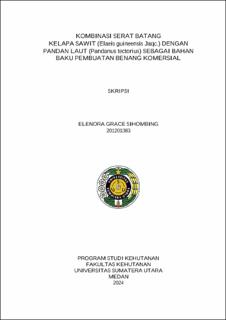Kombinasi Serat Batang Kelapa Sawit (Elaeis guineensis Jaqc.) dengan Pandan Laut (Pandanus tectorius) sebagai Bahan Baku Pembuatan Benang Komersial
Combination of Oil Palm Stem Fiber (Elaeis guineensis Jacq.) with Sea Pandan Fiber (Pandanus tectorius) as Raw Material for Making Commercial Yarn

Date
2024Author
Sihombing, Elenora Grace
Advisor(s)
Risnasari, Iwan
Nuryawan, Arif
Metadata
Show full item recordAbstract
The increasing demand for raw materials in the textile industry can be overcome in an alternative way, namely by using oil palm stem and sea pandan waste. This research examines the use of oil palm stem waste as raw material for making commercial yarn using a combination of sea pandan leaf strings with bleached and unbleached oil palm stem fiber treatment. The aim of this research is to evaluate the potential of oil palm stems and sea pandan leaves as raw materials for making yarn. commercially through several tests carried out chemically. Physical and mechanical properties include fiber anatomy, water content, hemicellulose content, cellulose content, lignin content, yarn tensile strength. The average water content of oil palm and sea pandan stems is 44,27% and 14,16%. The average hemicellulose content of oil palm and sea pandan stems were 25% and 42%. The average value of cellulose content of oil palm and sea pandan stems were 80.3% and 69.44%. The average value of lignin content in oil palm and sea pandan stems were 21% and 21.7%. The results of testing the tensile strength of the yarn obtained a tension value in the bleached thread of 13.55N and in the unbleached thread of 12.70N, the tension value in the thread bleached was 0.042 and unbleached was 0.043 and the Young's modulus value for bleached and unbleached yarns were 333.19 MPa and 319,86 MPa. The Young's modulus value was directly proportional to the stress value and inversely proportional to the stress value
Collections
- Undergraduate Theses [2170]
